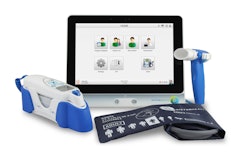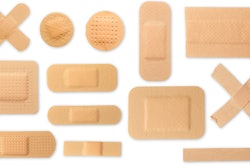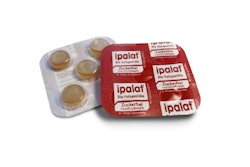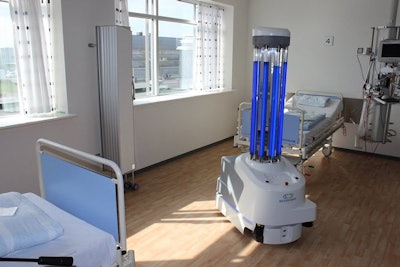
As everyone around the world tries to cope with the COVID-19 pandemic, healthcare workers are struggling to keep themselves healthy and the rest of us (hopefully) continue to maintain our distance. It’s a good time to remember the three Ds of robotics—dirty, dull, and dangerous. Sales of medical robots had already increased by 50% in 2018, according to the International Federation of Robotics (IFR). But the coronavirus outbreak highlights some key use cases for mobile robotics in particular as robotic systems move in to disinfect facilities, provide surveillance, material handling, and help with deliveries.
Mobile robots are so much in demand for these use cases right now—driven by a shift in understanding of what these platforms can do—that tech market advisory firm ABI Research expects the overall mobile robotics market to grow to $23 billion by 2021. “Crises shift perceptions on what is possible regarding investment and transformative action on the part of both private and government actors,” said Rian Whitton, senior analyst at ABI Research. “By the time the COVID-19 pandemic has passed, robots will be mainstreamed across a range of applications and markets.”
One of the more popular uses of robotics has been deploying autonomous mobile systems to disinfect facilities. These ultraviolet disinfection (UVD) robots use UV light to kill harmful microorganisms and have been in high demand since the coronavirus outbreak. “Automating disinfection is a key part of maintaining health and safety and could be one of the major bright spots in the response to COVID-19,” Whitton said.
Denmark-based UVD Robots is scaling up deployments of its robots to disinfect hospitals; U.S.-based GermFalcon is offering a similar UV disinfection solution for aircraft; and China’s TMiRob has been deploying disinfection robots in Wuhan, China. Chinese hospitals have ordered more than 2,000 UVD robots from Blue Ocean Robotics, according to the IFR, which, along with IEEE, awarded Blue Ocean’s UVD Robots subsidiary the IERA Award in 2019. The robots started to destroy viruses in Wuhan, where the global pandemic began, and now operate in more than 40 countries in Asia, Europe, and the U.S.
“We are now helping solve one of the biggest problems of our time, preventing the spread of viruses and bacteria with a robot that saves lives,” said Claus Risager, CEO of Blue Ocean Robotics. “The immediate demand has increased a lot with the outbreak of COVID-19. Existing customers buy many more units than before, and many new customers are ordering the UVD robots to fight coronavirus and other harmful microorganisms.”
“In a severe crisis like this where the world health is threatened, our innovative technology really proves its worth,” added Per Juul Nielsen, CEO of UVD Robots.
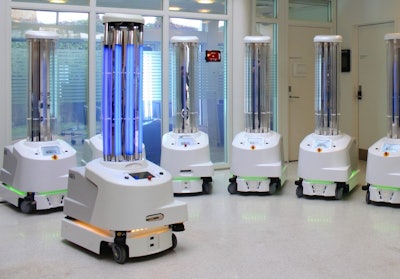 Mobile robots use ultraviolet light to disinfect hospitals and other facilities.UVD Robots
Mobile robots use ultraviolet light to disinfect hospitals and other facilities.UVD Robots
“Robots have a great potential of supporting us in the current severe corona pandemic,” said Dr. Susanne Bieller, general secretary of the IFR. “They can support us in healthcare environments, but also in the development, testing and production of medicine, vaccines and other medical devices and auxiliaries.”
Speedy delivery
Autonomous robots are becoming more commonplace in hospital environments, where they can be used to deliver supplies throughout the facility. The COVID-19 pandemic presents even more reason to use mobile robots for the safe distribution of hospital materials in quarantine zones, Bieller noted, citing Photoneo´s mobile robot Phollower as an example.
During the crisis, drones have been deployed to enforce curfews and provide security surveillance, increasing sales of the robotic devices to government agencies. In the short term, to enforce quarantine mandates, governments will need to increase their security apparatuses, as well as the productivity of their medical agencies, ABI Research notes.
With stay-at-home orders in place around the globe, there’s an opportunity for robot delivery companies to show their value. The drone delivery market could take its experience from transporting supplies in the developing world to scale up operations in the most affected countries. The research firm expect that potential to translate into a $414 million small drone delivery market by 2021, growing further to $10.4 billion by 2030.
Reshoring manufacturing
In the U.S., one of the effects of the current pandemic is a harder look at our dependence on Chinese imports for basic equipment and medicines. The growth of reshoring of manufacturing in this country has depended heavily on the use of robotics. So, if government representatives take this opportunity to push for renewed reshoring of key goods, the robotics industry could benefit considerably from the capex increases.
ABI Research’s Whitton recommended that “industrial players develop customized solutions for non-manufacturing use cases or look to build comprehensive solutions for enabling a scale-up in medical supply manufacturing. For mobile robotics vendors and software companies targeting more nascent markets, this represents a big chance to highlight the importance of robotics for dealing with national emergencies, as well as mitigating the economic shock.”
ABI Research has more to say on the current and future ramifications of COVID-19 across technologies and verticals, as well as the pandemic is likely to affect manufacturers’ spending on enterprise resource planning (ERP).
As the pandemic continues to impact lives daily, PMMI is using its channels to offer insights and reinforce that we are in this together. Listen to the special UnPACKed with PMMI podcast series to learn how PMMI’s members are navigating the COVID-19 crisis.
More on COVID-19 developments:
- Automation Suppliers Aid in the Fight Against COVID-19
- Telehealth, Home Devices Help Increase Bed Capacity in Hospitals
- Packaging and Processing Industry COVID-19 Resources
- FDA Town Halls on COVID-19 Diagnostic Tests
- All Roads Lead to Delay in the Time of COVID-19
- Thermo Fisher, Roche Begin Large-Scale Shipping of COVID-19 Tests
- Quick Hits: Hospitals Use AI to Diagnose Coronavirus

